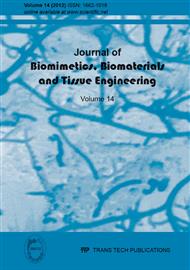[1]
K. Oktay, O. Oktem; Ovarian cryopreservation and transplantation for fertility preservation for medical indications: report of an ongoing experience, Fertil. Steril. (2008), 93 (3), 762-8.
DOI: 10.1016/j.fertnstert.2008.10.006
Google Scholar
[2]
H. Sitte, L. Edelmamm, K. Neumann; Cryofixation without pretreatment at ambient pressure, in Cryotechniques in Biological Electron Microscopy (Springer-Verlag, Berlin, 1987).
DOI: 10.1007/978-3-642-72815-0_4
Google Scholar
[3]
M. Toner, E. G Cravalho, M. Karel; Thermodynamics and kinetics of intracellular ice formation during freezing of biological cells, J. Appl. Phys. (1989), 67 (3), 1582-93.
DOI: 10.1063/1.345670
Google Scholar
[4]
A. N Gent, D. A Tompkins; Surface energy effects for small holes or particles in elastomers, J. Polym. Sci., Part A-2 (1969), 7 (9), 1483-7.
DOI: 10.1002/pol.1969.160070904
Google Scholar
[5]
K. Foroutan-pour, P. Dutilleul, D. L Smith; Advances in the implementation of the box-counting method of fractal dimension estimation, Appl. Math. Comput. (1999), 105 (2-3), 195-210.
DOI: 10.1016/s0096-3003(98)10096-6
Google Scholar
[6]
G. Bianciardi, M. Buonsanti, A. Pontari, S. Tripodi; Emerging microstructure in biological tissue under thermo-mechanical actions, ICTE2009 Proceedings (IST Press, Lisbona, 2009), 25.
Google Scholar
[7]
A. Visintin; Models of Phase Transitions (Birkauser, Boston, 1996).
Google Scholar
[8]
S. Li, G. Wang; Introduction to Micromechanics and Nanomechanics (World Scientific, London, 2008).
Google Scholar
[9]
M. H Sadd; Elasticity (Elsevier, Amsterdam, 2005).
Google Scholar
[10]
B. Hou, Q. S Zheng, Y. Huang; A note on the effect of surface energy and void size to void growth, Eur. J. Mechanics A/Solids (1999), 18 (6), 987-94.
DOI: 10.1016/s0997-7538(99)00133-3
Google Scholar
[11]
C. Fond; Cavitation Criterion for Rubber Materials: A Review of Void-Growth Models, J. Polym. Sci. Part B: Polym. Phys. (2001), 39 (17), 2081-96.
DOI: 10.1002/polb.1183
Google Scholar
[12]
K. J Falconer; Fractal Geometry: Mathematical Foundations and Applications (John Wiley & Sons Ltd, 2003).
Google Scholar
[13]
A. L Goldberger, D. R Rigney, B. J West; Chaos and fractals in human physiology, Sci. Am. (1990), 262 (2), 42-9.
DOI: 10.1038/scientificamerican0290-42
Google Scholar
[14]
O. Heymans, J. Fissette, P. Vico, S. Blacher, D. Masset, F. Brouers; Is fractal geometry useful in medicine and biomedical sciences?, Medical Hypothesis (2000), 54 (3), 360-66.
DOI: 10.1054/mehy.1999.0848
Google Scholar
[15]
C. Traversi, G. Bianciardi, A. Tasciotti, E. Berni, E. Nuti, P. Luzi, G. M Tosi; Fractal analysis of fluoroangiographic patterns in anterior ischemic optic neuropathy and optic neuritis: a pilot study, Clin. Experiment Ophthalmol. (2008).
DOI: 10.1111/j.1442-9071.2008.01766.x
Google Scholar
[16]
G. Bianciardi, C. Miracco, M. M De Santi, P. Luzi; Differential diagnosis between mycosis fungoides and chronic dermatitis by fractal analysis, J. Dermatol. Sci. (2003), 33 (3), 184-6.
DOI: 10.1016/j.jdermsci.2003.07.001
Google Scholar
[17]
A. Daxer; Characterization of the neovascularization process in diabetic retinopathy by means of fractal geometry: diagnostic implications, Graefe's Arch. Clin. Exp. Ophthal. (1993), 231 (12), 681-6.
DOI: 10.1007/bf00919281
Google Scholar
[18]
G. Latini, G. Bianciardi, S. Parrini, R. N Laurini, C. De Felice; Abnormal oral vascular network pattern geometry: a new clinical sign of Down syndrome, J. Pediatr. (2006), 148 (1), 132-7.
DOI: 10.1016/j.jpeds.2005.08.049
Google Scholar
[19]
F. Lefebre, H. Benali, R. Gilles, E. Kahn, R. Di Paola; A fractal approach to the segmentation of microcalcification in digital mammograms, Med. Phys. (1995), 22 (4), 381-90.
DOI: 10.1118/1.597473
Google Scholar
[20]
G. A Losa, G. Baumann, F. Nonnenmacher; Fractal dimension of pericellular membranes in human lymphocytes and lymphoblastic leukemia cells, Pathol. Res. Pract. (1992), 188 (4-5), 680-6.
DOI: 10.1016/s0344-0338(11)80080-4
Google Scholar


